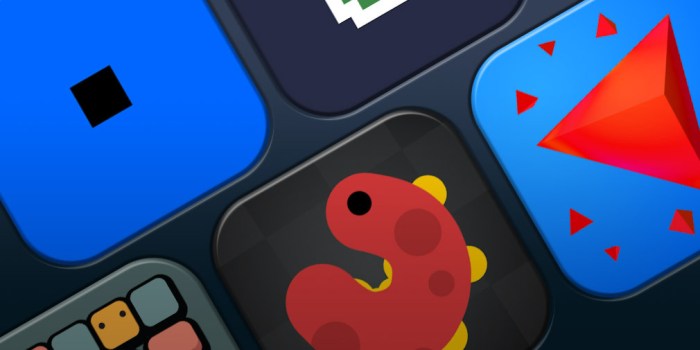
Ever wondered what makes those addictive mobile puzzle games so captivating? It’s more than just colorful tiles and satisfying swipes; it’s a carefully crafted blend of engaging mechanics, clever design, and often, a healthy dose of competition. From the classic match-3 to innovative new puzzle types, the world of online mobile puzzle games is a vibrant ecosystem of creativity and strategy, constantly evolving to keep players hooked.
This exploration delves into the heart of this booming industry, examining everything from market trends and monetization strategies to the psychology of addictive gameplay and the challenges of development.
We’ll uncover the secrets behind the success of top-performing games, analyze different monetization models, and even peek into the future of puzzle game design. Prepare to unlock the puzzle of what makes these games so undeniably popular, and perhaps even discover the inspiration to create your own!
Market Analysis of Online Mobile Puzzle Games

The online mobile puzzle game market is a vibrant and rapidly expanding sector within the broader mobile gaming industry. Its enduring popularity stems from the accessibility, diverse gameplay mechanics, and the inherent satisfaction derived from solving challenges. This analysis delves into the market size, leading titles, monetization strategies, and key genre characteristics to provide a comprehensive overview.
Current Market Size and Growth Potential
The global market for mobile puzzle games is substantial and continues to grow at a significant pace. While precise figures fluctuate based on reporting agencies and methodologies, estimates consistently place the market value in the billions of dollars annually. Factors contributing to this growth include the increasing penetration of smartphones globally, the expanding casual gaming audience, and the continuous innovation in game design and monetization strategies.
The potential for future growth remains strong, driven by advancements in mobile technology, the integration of augmented reality (AR) and virtual reality (VR) elements, and the exploration of new puzzle mechanics and game formats. For example, the rise of hyper-casual games, often featuring simple yet addictive puzzle elements, has significantly contributed to market expansion.
Top 5 Most Popular Online Mobile Puzzle Games and Their Success Factors
Pinpointing the exact top 5 is challenging as rankings vary across platforms and time periods. However, consistent contenders include Candy Crush Saga, Gardenscapes, Homescapes, Sudoku.com, and Wordscapes. Their success hinges on a combination of factors: addictive gameplay loops, regular content updates, effective social features (encouraging player interaction and competition), skillful monetization strategies (discussed further below), and targeted marketing campaigns.
Candy Crush Saga, for instance, expertly uses a freemium model with well-placed in-app purchases and engaging level design to maintain player retention. Gardenscapes and Homescapes successfully blend puzzle gameplay with narrative elements and visually appealing aesthetics. Sudoku.com benefits from its classic, universally recognized puzzle format and its easy accessibility. Wordscapes leverages word-puzzle mechanics with a similar appealing aesthetic to Gardenscapes and Homescapes.
Monetization Strategies of Leading Online Mobile Puzzle Game Developers
Leading developers primarily utilize two main monetization strategies: in-app purchases (IAPs) and advertising. The freemium model, which combines free-to-play gameplay with optional IAPs, is dominant. IAPs can range from purchasing in-game currency to acquire power-ups or extra lives, to unlocking new levels or content packs. Advertising, particularly rewarded video ads, offers another revenue stream, providing players with incentives (like extra lives or boosts) for watching short video advertisements.
Many successful games employ a hybrid approach, carefully balancing IAPs and ads to maximize revenue without alienating players with overly intrusive monetization. For example, some games offer an “ad-free” IAP option, allowing players to pay a one-time fee to remove ads entirely.
Key Features and Demographics of Different Online Mobile Puzzle Game Genres
| Genre | Key Features | Target Demographic | Monetization Focus |
|---|---|---|---|
| Match-3 | Simple mechanics, colorful visuals, cascading effects, power-ups | Broad appeal, particularly casual gamers of all ages | IAPs (lives, boosters), rewarded video ads |
| Jigsaw | Image-based puzzles, varying difficulty levels, themed collections | Relaxation-focused players, broader age range | IAPs (new packs, hints), subtle ads |
| Sudoku | Number-placement puzzle, logic-based gameplay, varying difficulty | Older demographic, puzzle enthusiasts, those seeking mental stimulation | IAPs (hints, themes), subscription models (ad-free) |
| Word | Letter-based puzzles, word finding, anagrams, crossword-style | Broad appeal, particularly those who enjoy word games and brain teasers | IAPs (hints, boosters), rewarded video ads |
Gameplay Mechanics and Design of Online Mobile Puzzle Games
The success of online mobile puzzle games hinges on a delicate balance of simple, intuitive mechanics and cleverly designed challenges that keep players engaged for extended periods. This requires a deep understanding of player psychology and a commitment to crafting a compelling and rewarding experience. Effective gameplay mechanics, thoughtful level design, and intuitive user interfaces are all crucial elements.
Core gameplay mechanics often revolve around simple, yet satisfying actions. Matching colors, manipulating shapes, or solving spatial puzzles are all common examples that require minimal instruction yet offer significant depth. The best games build upon these foundational mechanics, introducing new challenges and twists as the player progresses. This gradual introduction of complexity is key to preventing frustration while maintaining a high level of engagement.
The sense of accomplishment derived from successfully overcoming increasingly difficult challenges is a major driver of player retention.
Level Design and Progression
Level design plays a pivotal role in the long-term enjoyment of a mobile puzzle game. A well-designed game features a carefully curated progression of challenges, gradually increasing in difficulty. Early levels serve as tutorials, introducing core mechanics and establishing a rhythm of play. Subsequent levels then introduce new mechanics, obstacles, and variations on existing gameplay, keeping the experience fresh and preventing monotony.
Furthermore, the inclusion of power-ups or special abilities can add another layer of strategic depth and reward skillful play. Games like Candy Crush Saga exemplify this approach, offering a seemingly endless stream of increasingly complex levels that maintain player engagement. Poorly designed levels, on the other hand, can lead to frustration and player churn. A sudden spike in difficulty, repetitive level designs, or unfair challenges can quickly turn players away.
A Novel Puzzle Game Mechanic: “Chain Reaction”
Imagine a puzzle game where colored orbs are arranged on a grid. The player must tap on an orb to trigger a chain reaction. Tapping an orb causes it to change color, and this color change propagates to adjacent orbs of the same color, creating a cascading effect. The goal is to strategically trigger chain reactions to eliminate all orbs of a specific color before the timer runs out.
The challenge lies in anticipating the cascading effects and planning multiple moves ahead. The introduction of different orb types with unique properties (e.g., orbs that change multiple adjacent orbs, orbs that block chain reactions) could add significant strategic depth. The potential appeal lies in the satisfying visual feedback of the chain reactions and the strategic depth required to master the cascading effects.
This mechanic offers a unique blend of planning and reactive gameplay, potentially setting it apart from existing puzzle games.
User Interface and User Experience Comparison
Popular puzzle games like Candy Crush Saga, Bejeweled Blitz, and Tetris Blitz showcase different approaches to UI/UX design. Candy Crush Saga features a bright, cartoonish aesthetic with clear visual cues and intuitive controls. Bejeweled Blitz prioritizes speed and simplicity, featuring a streamlined interface focused on quick matches. Tetris Blitz maintains the classic Tetris gameplay but incorporates modern UI elements and power-ups for a more dynamic experience.
These examples demonstrate how different design choices can cater to various player preferences and gameplay styles. A successful mobile puzzle game needs a UI that is intuitive, visually appealing, and seamlessly integrates with the core gameplay mechanics, minimizing distractions and maximizing enjoyment. A poor UI, on the other hand, can hinder the gameplay experience and ultimately detract from the overall enjoyment.
Social and Competitive Aspects of Online Mobile Puzzle Games
Online mobile puzzle games thrive not just on individual skill but also on the social and competitive dynamics they foster. The ability to connect with friends, compete on leaderboards, and participate in events significantly impacts player engagement and retention. These elements transform a solitary puzzle-solving experience into a vibrant, interactive community.
The integration of social and competitive features significantly enhances the overall player experience. It transforms a potentially solitary activity into a shared experience, increasing both enjoyment and longevity. This section will explore the key features that drive this engagement and the impact they have on the success of these games.
Features Promoting Social Interaction
Social interaction is a cornerstone of successful online mobile puzzle games. Features that facilitate this interaction create a sense of community and encourage continued play. These features not only entertain but also contribute to the game’s overall longevity and player retention.
A robust social system often includes several key components. The most common are friend lists, allowing players to connect with known individuals; in-game chat features, enabling real-time communication during gameplay or within guilds; and gifting systems, where players can send virtual gifts to one another. These simple features build relationships and a sense of belonging within the game’s ecosystem.
Impact of Competitive Elements on Player Engagement and Retention
Competition adds another layer to the engagement. Leaderboards provide a clear visual representation of player skill and progress, motivating players to improve their scores and climb the ranks. This intrinsic motivation drives continuous play, particularly in games with regular updates and events. Tournaments and challenges, with rewards for top performers, further enhance this competitive spirit. The desire to outdo others fuels player engagement, creating a sustainable player base.
For example, Candy Crush Saga’s frequent updates introducing new challenges and events keep players actively engaged in the competitive landscape.
The competitive aspect, however, needs careful management. While a healthy dose of competition is beneficial, overly aggressive or unfair competitive elements can alienate players. A balanced approach, ensuring that players of all skill levels feel a sense of accomplishment and progress, is crucial for long-term success. Games like Puzzle Quest: Challenge of the Warlords demonstrate this balance by offering both competitive and collaborative modes of play, catering to diverse player preferences.
Incorporating Social Features to Enhance Player Experience
Effective incorporation of social features requires a nuanced understanding of player psychology. Features should be seamlessly integrated into the core gameplay loop, not feel like an afterthought. For instance, integrating cooperative puzzle-solving modes allows players to work together to overcome challenges, fostering collaboration and camaraderie. Similarly, the ability to share achievements on social media platforms extends the social experience beyond the confines of the game itself.
Furthermore, incorporating asynchronous gameplay elements, such as allowing players to send and receive challenges at their own pace, caters to diverse player schedules and preferences. This fosters a more inclusive and accessible social experience, ensuring a broader range of players can actively participate and enjoy the social aspects of the game. Games that excel in this area often feature regular updates with new social features and events to keep players engaged and returning for more.
Features Fostering a Competitive Yet Friendly Online Gaming Community
Creating a positive and engaging community is essential for the long-term success of any online game. This requires a balance between competition and collaboration.
A well-designed system might include features such as:
- Guilds or Clans: Allowing players to form groups and collaborate on challenges.
- In-game Chat: Facilitating communication and fostering a sense of community.
- Friendly Competition Events: Focusing on collaboration and teamwork rather than purely individual performance.
- Reward Systems that Encourage Helpfulness: Giving rewards for assisting other players.
- Moderation Systems: Maintaining a positive and respectful environment by addressing toxic behavior.
By carefully implementing these features, developers can cultivate a vibrant and supportive community that enhances the overall player experience and contributes significantly to the game’s longevity.
Online Game Development Aspects

Creating a successful online mobile puzzle game requires a strategic and iterative approach, encompassing design, development, testing, and optimization. This section details the key steps involved in bringing your puzzle game vision to life, ensuring it’s engaging, accessible, and performs flawlessly across various devices.
The development process is not a linear path, but rather a cyclical one involving constant refinement based on testing and user feedback. Each stage informs the next, leading to a polished and enjoyable final product.
Step-by-Step Guide to Online Mobile Puzzle Game Development
Developing an online mobile puzzle game involves a multi-stage process. Successful games are built through careful planning and execution at each step.
- Concept and Design: Define the core gameplay mechanics, target audience, and unique selling points. Create detailed game design documents outlining level design, art style, and monetization strategies. Consider examples like Candy Crush’s simple yet addictive gameplay or the unique puzzle mechanics found in Monument Valley.
- Prototyping: Develop a basic playable prototype to test core mechanics and refine the game design. This allows for early feedback and iteration before significant resources are committed to full development. Tools like Unity or Unreal Engine can greatly assist in this stage.
- Art and Asset Creation: Create the visual assets (characters, environments, UI elements) that define the game’s aesthetic. Consistent art style is critical for a cohesive user experience. Consider the stylistic choices in games like Two Dots or the minimalist aesthetic of Flow Free.
- Programming and Development: Implement the game’s core logic, networking features (for online play), and user interface. This involves writing code to handle game mechanics, user input, and data management. Languages like C# (with Unity) or C++ (with Unreal Engine) are commonly used.
- Testing and Quality Assurance (QA): Rigorous testing across various devices and operating systems is crucial. This includes identifying and fixing bugs, balancing gameplay, and ensuring a smooth user experience. Beta testing with a select group of players provides invaluable feedback.
- Deployment and Launch: Prepare the game for release on app stores (Apple App Store, Google Play Store). This involves creating marketing materials, setting up in-app purchases (if applicable), and managing app store listings.
- Post-Launch Support and Updates: Continuously monitor player feedback, address bugs, and release updates with new content and features. Maintaining an active community is essential for long-term success.
Optimizing for Mobile Devices and Operating Systems
Optimizing for diverse mobile devices and operating systems is paramount for broad player reach and positive reviews. This involves careful consideration of device capabilities and operating system limitations.
- Resolution Independence: Design assets to scale seamlessly across different screen sizes and resolutions, avoiding pixelation or distortion. This ensures the game looks good on all devices.
- Performance Optimization: Minimize resource consumption (CPU, memory, battery) to prevent lag or crashes, especially on lower-end devices. This often involves careful code optimization and asset compression.
- Platform-Specific Considerations: Account for variations in input methods (touchscreen vs. controller), hardware capabilities, and operating system features (e.g., push notifications). Adapt the game’s UI and controls for optimal usability on each platform.
- Adaptive UI: Design a user interface that dynamically adjusts to different screen sizes and orientations, ensuring readability and usability across devices.
The Importance of Testing and Iteration
Testing and iteration are not merely optional steps, but the cornerstones of successful game development. Continuous feedback loops are essential for creating a polished and enjoyable experience.
Regular testing throughout the development cycle, including alpha and beta testing phases, allows developers to identify and address issues early, saving time and resources in the long run. Iterative development involves making changes based on testing feedback, constantly refining gameplay and addressing user concerns.
Continuous feedback and iterative development are crucial for creating a polished and engaging online mobile puzzle game.
Essential Tools and Technologies
A variety of tools and technologies are used in the development of online mobile puzzle games. The choice depends on factors like the game’s complexity, budget, and developer expertise.
| Category | Tools/Technologies | Description |
|---|---|---|
| Game Engine | Unity, Unreal Engine, Godot | Provides a framework for game development, including tools for graphics rendering, physics simulation, and scripting. |
| Programming Languages | C#, C++, Java, Lua | Used for writing game logic, networking code, and UI interactions. |
| Art Tools | Adobe Photoshop, Illustrator, Blender | Used for creating 2D and 3D assets, such as character models, textures, and UI elements. |
| Version Control | Git | Tracks code changes, allowing for collaboration and easy rollback to previous versions. |
| Networking Libraries | Photon, Firebase | Enable real-time multiplayer functionality. |
| Analytics | Google Analytics, Firebase Analytics | Track player behavior, providing valuable insights for game improvement and monetization strategies. |
Free Online Games and Monetization Strategies
The success of a free-to-play (F2P) online mobile puzzle game hinges heavily on its monetization strategy. A well-designed system can generate substantial revenue while maintaining player engagement and satisfaction. Conversely, a poorly implemented strategy can drive players away and ultimately doom the game. This section explores various monetization techniques, their associated challenges and opportunities, and compares different business models prevalent in the F2P mobile game market.
Finally, a sample monetization strategy for a hypothetical puzzle game will be presented.
Monetization Strategies for Free-to-Play Mobile Puzzle Games
Several effective monetization strategies exist for free-to-play mobile puzzle games. These strategies often work best in combination, creating a diverse revenue stream. The key is to balance revenue generation with a positive player experience, avoiding the perception of being overly aggressive or exploitative.
- In-App Purchases (IAPs): This is the most common monetization method. IAPs can include purchasing in-game currency to buy power-ups, extra lives, hints, or cosmetic items like unique puzzle boards or character skins. Successful IAP implementation requires careful balancing of pricing and value to avoid player frustration.
- Interstitial and Rewarded Video Ads: Interstitial ads appear between levels or game sessions, while rewarded video ads offer players a bonus (like extra lives or currency) for watching a short video advertisement. The frequency and intrusiveness of these ads must be carefully managed to avoid alienating players. Rewarded video ads are generally preferred as they offer players a choice and feel less disruptive.
- Subscription Models: Offering a subscription unlocks premium features, such as ad-free gameplay, exclusive content, or access to special events. This model provides a consistent revenue stream but requires offering substantial value to justify the subscription cost. Examples include monthly or annual passes.
- Affiliate Marketing: Partnering with other companies to promote their products or services within the game can generate additional revenue. This requires careful selection of partners to ensure alignment with the game’s brand and target audience. It should be implemented subtly and not feel forced upon the player.
Challenges and Opportunities in Creating Successful Free-to-Play Online Mobile Puzzle Games
The free-to-play market is highly competitive, presenting both challenges and significant opportunities.
- Challenge: Balancing Monetization and Player Experience: The delicate balance between generating revenue and maintaining a positive player experience is crucial. Aggressive monetization can lead to negative reviews and player churn, while insufficient monetization can hinder profitability.
- Challenge: Attracting and Retaining Players: Standing out in a crowded market requires a compelling game design, effective marketing, and ongoing engagement strategies. Regular updates, new content, and community building are essential for long-term success.
- Opportunity: Global Reach and Scalability: Mobile games offer access to a vast global audience, allowing for significant scalability. Successful games can reach millions of players worldwide.
- Opportunity: Diverse Monetization Models: The flexibility of F2P allows for experimentation with different monetization models to find the optimal combination for the specific game and target audience. This allows for iterative improvement based on player data.
Comparison of Business Models in the Free Online Game Market
Several business models exist within the F2P mobile game market, each with its own strengths and weaknesses. A common approach is a hybrid model, combining several strategies for a diversified revenue stream.
| Business Model | Description | Advantages | Disadvantages | Example |
|---|---|---|---|---|
| Freemium | Free to play with optional IAPs | Wide reach, potential for high revenue | Requires careful IAP balancing, risk of negative player perception | Candy Crush Saga |
| Ad-supported | Free to play with ads as the primary revenue source | Simple implementation | Can be disruptive to gameplay, lower revenue potential than IAPs | Many casual puzzle games |
| Subscription | Recurring payments for premium features | Stable revenue stream | Requires significant value proposition, potential for churn | Some puzzle games offer season passes |
| Hybrid | Combination of multiple models | Diversified revenue streams, greater flexibility | More complex to implement and manage | Many successful mobile puzzle games |
Monetization Strategy for a Hypothetical Online Mobile Puzzle Game: “Gemstone Quest”
“Gemstone Quest” is a match-3 puzzle game where players match colorful gemstones to clear levels and progress through a fantasy world.
- IAPs: Players can purchase “Gems,” the in-game currency, to buy extra lives, power-ups (like hammers to crush multiple gemstones or bombs to clear areas), and cosmetic items (unique gemstone skins).
- Rewarded Video Ads: Players can watch short video ads to earn extra lives or a small amount of Gems. Ads will be offered sparingly and only after completing levels.
- Subscription (“Gemstone Pass”): A monthly subscription will provide ad-free gameplay, a daily bonus of Gems, and exclusive access to special events and levels.
The rationale behind this strategy is to offer a balanced approach. IAPs provide a core revenue stream, while rewarded video ads offer players a choice and mitigate the negative impact of intrusive ads. The subscription model caters to dedicated players willing to pay for an enhanced experience. The pricing and value of each item will be carefully tested and adjusted based on player feedback and data analysis.
This approach prioritizes player experience while ensuring a sustainable revenue model for the game.
Online Games for Girls and Targeted Marketing
The mobile gaming market is booming, and a significant portion of that growth comes from female players. Understanding their preferences and tailoring marketing strategies accordingly is crucial for success in this sector. This section delves into the key elements that attract girls to online mobile puzzle games, effective marketing approaches to reach this demographic, and examples of games that have successfully tapped into this market.
Key Features and Themes Appealing to Female Players in Online Mobile Puzzle Games
Female gamers often gravitate towards games that offer visually appealing aesthetics, engaging storylines, and opportunities for social interaction. Puzzle games, in particular, benefit from incorporating themes of creativity, customization, and emotional connection. Games featuring charming characters, pastel color palettes, and relaxing soundtracks often resonate strongly. Furthermore, the inclusion of narrative elements, such as collecting items to progress a story or unlocking characters with unique backstories, significantly enhances engagement.
The focus is less on aggressive competition and more on relaxation, self-expression, and a sense of accomplishment.
Effective Marketing Strategies for Reaching Female Audiences Interested in Online Mobile Puzzle Games
Reaching the target female audience requires a nuanced marketing approach that moves beyond generic gaming advertisements. Influencer marketing, particularly through collaborations with female YouTubers and streamers known for their positive and relatable content, can be highly effective. Social media platforms like Instagram and TikTok, known for their visual emphasis and strong female user base, are ideal channels for showcasing gameplay and highlighting the game’s aesthetic appeal.
Targeted advertising on these platforms, focusing on specific interests like fashion, beauty, and lifestyle, ensures that the game’s message reaches the right audience. Furthermore, emphasizing the game’s relaxing and stress-relieving aspects can resonate with a busy female demographic seeking escapism and downtime.
Examples of Successful Online Mobile Puzzle Games that Have Targeted Female Audiences
Many successful mobile puzzle games have implicitly or explicitly targeted female audiences. Games likeCandy Crush Saga*, with its bright colors, sweet treats theme, and social features, have been incredibly popular among women. The game’s simplicity, combined with its addictive gameplay loop and social connectivity, has created a large and loyal female player base. Similarly, games featuring characters with strong female leads or storylines focused on themes of friendship and self-discovery can appeal to a specific female demographic.
While not always explicitly stated, the visual style and tone of these games effectively attract and retain a substantial female player base. The success of these titles underscores the importance of understanding and catering to the preferences of female gamers.
Marketing Plan for a New Online Mobile Puzzle Game Targeting Girls
This plan focuses on a new mobile puzzle game tentatively titled “Starlight Spells,” a match-three puzzle game with a magical girl theme.
Target Audience:
Girls aged 10-16 with an interest in fantasy, magical creatures, and creative expression.
Marketing Channels:
- Social Media Marketing: Run targeted ad campaigns on Instagram and TikTok showcasing vibrant gameplay footage and highlighting the game’s charming characters and magical theme. Collaborate with relevant female influencers to create engaging content and reviews.
- App Store Optimization (ASO): Optimize the game’s app store listing with relevant s and compelling visuals to improve organic discoverability.
- Influencer Marketing: Partner with popular female YouTubers and TikTokers known for their positive and family-friendly content to create sponsored gameplay videos and reviews.
- Public Relations: Reach out to family-focused gaming websites and publications to secure press coverage and reviews.
Messaging:
The marketing message will emphasize the game’s relaxing and enjoyable gameplay, its charming characters, and its focus on creative problem-solving. The visual elements will be bright, cheerful, and appeal to a younger female audience. The game’s tagline could be something like: “Unleash your inner magic with Starlight Spells!” This message directly speaks to the target audience’s interests and aspirations.
Addressing Concerns Related to Gambling and Online Casinos
The increasing popularity of online mobile games raises important questions about the potential for overlap with gambling activities. While many puzzle games offer purely skill-based challenges, the integration of gambling mechanics, even seemingly innocuous ones, can blur the lines and create ethical and legal concerns. This section clarifies the distinctions between these game types, examines the ethical implications of incorporating gambling elements, and explores the legal framework governing online gambling.Online mobile puzzle games and online casino games are fundamentally different.
Puzzle games typically rely on problem-solving skills and strategic thinking. Success is primarily determined by a player’s aptitude and planning, not by chance. Conversely, online casino games, such as slots, roulette, and blackjack, are games of chance where the outcome is largely determined by random number generators (RNGs). While some skill might be involved in strategy (like card counting in Blackjack), the core element is chance.
The key distinction lies in the predictability of the outcome; puzzle games offer a predictable outcome based on player actions, while casino games are inherently unpredictable.
Differences Between Online Mobile Puzzle Games and Online Casino Games
Puzzle games emphasize skill, strategy, and problem-solving. Progress is earned through player effort and intelligence. In contrast, casino games rely on chance and random number generation. The outcome is unpredictable, and success is largely determined by luck. A clear example is comparing a game like Candy Crush, where strategic moves lead to progress, to a slot machine, where the result is entirely random.
The former rewards skill, while the latter relies on chance.
Ethical Considerations of Incorporating Gambling Elements into Online Games
Integrating gambling mechanics into online games raises significant ethical concerns, especially regarding vulnerable populations like children and adolescents. The potential for addiction and financial harm is a serious consideration. The design of such games needs to prioritize responsible gaming practices, such as clear limits on spending, age verification, and readily available resources for problem gamblers. The ethical dilemma lies in balancing the pursuit of profit with the responsibility of protecting players from potential harm.
For instance, “loot boxes,” often found in free-to-play games, have drawn criticism for their similarity to gambling, despite not directly involving real money transactions. The perceived value and potential for addiction raise ethical questions about their design and implementation.
Legal and Regulatory Landscape Surrounding Online Gambling
The legal and regulatory landscape surrounding online gambling varies significantly across jurisdictions. Some countries have legalized and heavily regulate online gambling, establishing licensing requirements, responsible gaming guidelines, and measures to prevent underage access. Others maintain strict prohibitions against all forms of online gambling. This disparity creates challenges for game developers, who must navigate different legal frameworks depending on their target markets.
For example, the UK Gambling Commission sets stringent rules for online gambling operators, including advertising restrictions and player protection measures, whereas other countries may have far less stringent regulations or none at all. Understanding these legal nuances is critical for developers to ensure compliance and avoid legal repercussions.
Risks Associated with Problem Gambling and Resources for Responsible Gaming
Problem gambling, also known as compulsive gambling or gambling addiction, is a serious behavioral disorder that can lead to significant financial, social, and emotional problems. Individuals struggling with problem gambling may experience financial ruin, relationship breakdowns, and mental health issues. The risks are heightened with easy access to online gambling, which can lead to increased frequency and severity of gambling behavior.
Recognizing the signs of problem gambling is crucial. These signs can include neglecting responsibilities, chasing losses, lying about gambling habits, and experiencing withdrawal symptoms when unable to gamble. Several organizations offer resources and support for individuals struggling with problem gambling, including Gamblers Anonymous, the National Council on Problem Gambling, and BeGambleAware. These organizations provide confidential help, support groups, and treatment options.
Summary
From market analysis to the intricacies of game design and monetization, our journey into the world of online mobile puzzle games has revealed a fascinating landscape. The key to success lies not only in creating engaging gameplay but also in understanding the players themselves – their motivations, their preferences, and their desire for both challenge and social interaction. Whether you’re a seasoned developer, a curious gamer, or simply someone fascinated by the power of puzzles, we hope this exploration has provided valuable insights into this captivating corner of the digital world.
Now, go forth and conquer those puzzles!
Expert Answers
What are the most common platforms for online mobile puzzle games?
iOS and Android are the dominant platforms, catering to the vast majority of mobile gamers.
How much does it cost to develop a mobile puzzle game?
Development costs vary wildly, depending on complexity, features, and team size. Simple games can cost thousands, while complex titles can reach hundreds of thousands or even millions.
What are some effective marketing strategies for mobile puzzle games?
App store optimization (ASO), social media marketing, influencer collaborations, and targeted advertising are all effective strategies.
How can I prevent my mobile puzzle game from becoming repetitive?
Regular content updates, diverse level design, unlockable features, and challenges are crucial to maintaining player engagement.
Are there any legal issues I should be aware of when developing a mobile puzzle game?
Copyright and intellectual property concerns, data privacy regulations (like GDPR and CCPA), and terms of service agreements are all important legal considerations.






